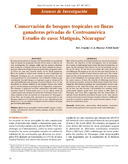| dc.contributor.author | Useche, D.C. | es_ES |
| dc.contributor.author | Harvey, Celia A. | es_ES |
| dc.contributor.author | DeClerck, Fabrice A. J. | es_Es |
| dc.date.accessioned | 2015-11-18T06:02:09Z | |
| dc.date.available | 2015-11-18T06:02:09Z | |
| dc.date.issued | 2013-07-15 | es_ES |
| dc.identifier.issn | 1022-7482 | es_ES |
| dc.identifier.uri | https://repositorio.catie.ac.cr/handle/11554/7789 | |
| dc.description.abstract | La mayoría de parches de bosque en Centroamérica se encuentran bajo el sistema de propiedad privada. Por lo tanto, el objetivo de esta investigación fue indagar cuáles son las razones existentes para mantener el bosque dentro de las fincas, señalar las estrategias que utilizan los finqueros para su protección y preguntar sobre el futuro de cada área boscosa dentro de las fincas ganaderas. Para este trabajo se utilizó como estudio de caso el municipio de Matiguás, Nicaragua, por ser un paisaje representativo de otras zonas ganaderas de Centroamérica. Los resultados señalaron que
actualmente hay más bosque en el paisaje ya que se disminuyó la tala, principalmente para proteger el recurso hídrico. A su vez, los beneficios de obtener madera de los bosques fueron otra razón por la cual los finqueros protegieron los fragmentos remanentes. No obstante, el pago por servicios ambientales sobresalió como
incentivo hacia la conservación, pero a su vez, figuró como un condicionante para asegurar la protección del bosque. Estos resultados también se han encontrado en otras partes de Nicaragua y Costa Rica, por lo tanto, debe potenciarse la conservación de los bosques riparios en Centroamérica que ya son valorados por los finqueros y a su vez analizar el impacto socioeconómico del pago por servicios ambientales. | es |
| dc.description.abstract | Most of forest patches in Central America are on private property. Therefore the objective of this investigation was to investigate the reasons of maintaining forest inside this kind of properties, to point out the strategies that farmers use for its protection and to ask on the future of each forest area inside the cattle farms. We used Matiguás, Nicaragua as the site for this case study because it is representative of other Central America cattle areas. The results point out that at the moment there is more forest in the landscape since it has diminished the pruning mainly for the protection of the water resource. In turn, the benefits of obtaining wood from the forests was another reason for which farmer protect the forest fragments. Nevertheless, payment for environmental services was mentioned as the most interesting motivation for conservation, but in turn, has also become a precondition for ensuring forest conservation. Similar results have been found in other parts of Nicaragua and Costa Rica, suggesting that the conservation of riparian forests should be prioritized because of the value placed on these forests by Central American farmers. However additional research is needed to analyze the socioeconomic impact of payment for ecosystem services. | en_EN |
| dc.description.sponsorship | CATIE (Centro Agronómico Tropical de Investigación y Enseñanza) | es |
| dc.language.iso | es | es |
| dc.relation.ispartof | Programa Agroambiental Mesoamericano (MAP). Fase I | |
| dc.relation.ispartof | Agroforestería en las Américas;No. 48 (2011), páginas 76-83 | es_ES |
| dc.subject | BOSQUES | es |
| dc.subject | PROTECCION FORESTAL | es |
| dc.subject | BIODIVERSIDAD | es |
| dc.subject | PAISAJE | es |
| dc.subject | PROPIEDAD PRIVADA | es |
| dc.subject | SERVICIOS AMBIENTALES | es |
| dc.subject | ZONAS RURALES | es |
| dc.subject | NICARAGUA | es |
| dc.title | Conservación de bosques tropicales en fincas ganaderas privadas de Centroamérica Estudio de caso: Matiguás, Nicaragua | es |
| dc.type | Artículo | es_ES |


